#Laptops IBM
Text
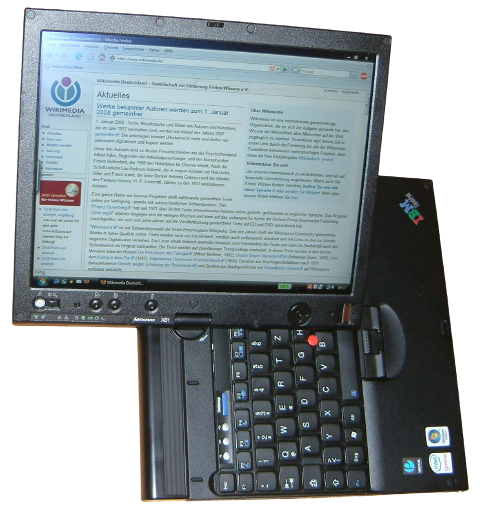
ibm thinkpad x61t (2007), a tablet laptop
538 notes
·
View notes
Text
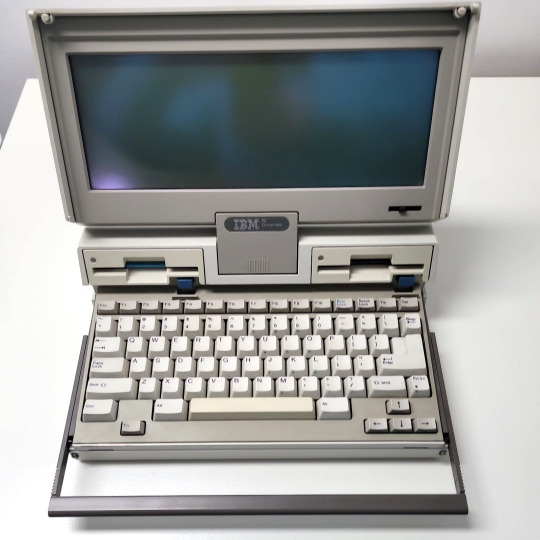
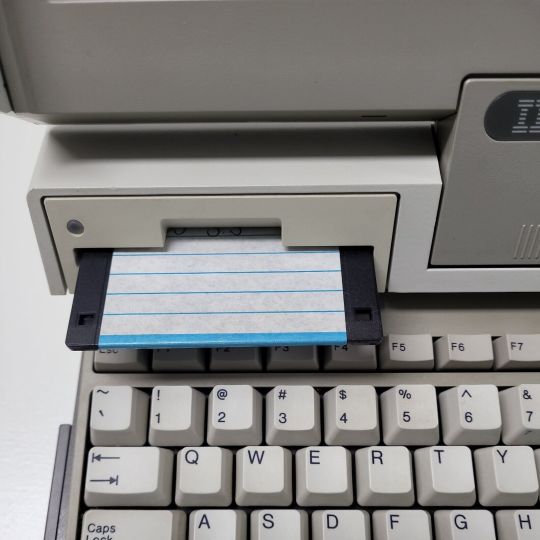
IBM PC Convertible 5140
595 notes
·
View notes
Text

1K notes
·
View notes
Text

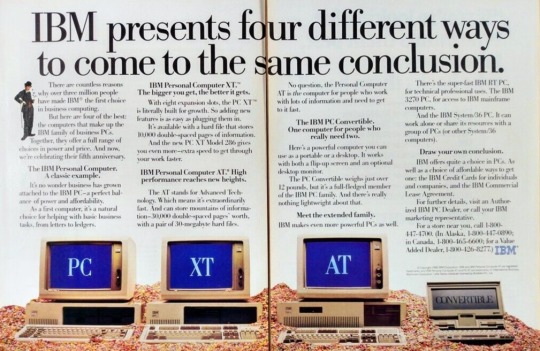


🇺🇸 Step back in time to 1986 and witness the dawn of a revolutionary device—the IBM PC Convertible. As one of the earliest portable computers, the PC Convertible marked a significant milestone in the evolution of American personal computing, offering newfound mobility and versatility to professionals and enthusiasts alike.
💻 The IBM PC Convertible represented IBM's inaugural foray into creating a portable version of its iconic PC line. It was the first laptop-style computer following the luggable IBM Portable, and notably introduced the 3½-inch floppy disk format to the IBM product line. Featuring a clamshell design this groundbreaking device set the stage for future generations of laptops. Its compact form factor and relatively lightweight made it a practical choice for on-the-go computing—a novel concept at the time.
⌨️ Unlike earlier portable computers that required external keyboards, the PC Convertible boasted a built-in keyboard, enhancing its usability and convenience.
👉 The PC Convertible came in three models: PC Convertible, PC Convertible Model 2, and Model 3. The latter two were released in October 1987 and are primarily distinguished by their LCD panels. The original Convertible used a non-backlit panel, which was considered difficult to read. The Model 2 lacked a backlight as well but upgraded to an improved supertwist panel, while the Model 3 included a backlight.
🖥️ Equipped with an innovative flip-up monochrome, CGA-compatible LCD screen, the PC Convertible offered a crisp display for viewing documents and running applications—a revolutionary feature for its time.
💾 Powered by an Intel 80C88 CPU, the PC Convertible came with built-in storage options, including 256 KB of RAM (expandable to 640 KB) and dual 720 KB 3.5-inch floppy drives, enabling users to store and access data with ease. It also featured serial and parallel ports for connecting peripherals.
🔋 Despite its modest battery life by today's standards, the PC Convertible offered respectable uptime, allowing users to work on the go without being tethered to a power source. Weighing just over 12 pounds and featuring a built-in carrying handle, the PC Convertible's battery was rated for 10 hours.
🌟 The IBM PC Convertible was succeeded in 1991 by the PS/2 L40 SX, and in Japan by the IBM Personal System/55note, the predecessor to the ThinkPad. The IBM PC Convertible left an indelible mark on the history of computing, paving the way for the modern laptops we use today. Its innovative design and practical features demonstrated the potential of portable computing, inspiring subsequent advancements in mobile technology.
#old technology#techtime chronicles#companies#tech#technology#old tech#technews#information technology#corporations#electronics#ibm#ibm corporation#ibm pc1#ibm pc#ibm pc convertible#laptops#laptop#computer science#computing#computers#computer#old computers#hardware#software#innovation#made in america#made in usa#floppy disk#thinkpad#ibm pc-line
49 notes
·
View notes
Text

(2003年03月31日)
#totle sisters#aryuu sensei#ukgk#ukagaka#IBM#retro laptop#sora aoi#retro tech#Totle Tangerine#little witch toto-tan#artist:Midori Aro#Tokino
21 notes
·
View notes
Photo

ThinkPad T60P
31 notes
·
View notes
Text
everybody clap i finally got a windows xp laptop
#i got a fully refurbished one so ik i can trust it#cause alot of these other listings were like 'um yea the battery might not work idk and we wont give u the charger'#and shit like that so basically they were mainly for spares and parts and the actual era xp laptops#were sooooo expensive. i think the IBM Thinkpad was almost £1000 because they got it for £3000 when it was on sale 🙄#so i got a vista laptop with xp on it for £85 🤷🏾♀️ik there were cheaper ones but i was worried idk why like idk
12 notes
·
View notes
Text
Someone's RTX: video card
My RTX: Thinkpads R40, T42, X60

#Ibm#thinkpad#retro computers#retro laptops#early 2000's#retro#rtx meme#sarklives#sark lives#tron lives#tronlives
13 notes
·
View notes
Text
I.B.1698 MICHAEL [IBM] harrelltut.com of 1921steelecartel.com's Original quantumintranet.tech Cloud Service Architecture [CSA] @ QANTUMHARRELLTECH.ca.gov... since 1968michaelharrelljr.com of 144,000 quantumharrell.tech MINING PATENTS... Systematically Engineering anugoldenblackwallstreet.com WEALTH MANAGEMENT FIRM of ibmichaelstadtcoburg.com... as Eye Machine Accelerate Computational [iMAC] Computer Aided Drafting [CAD] Languages of PRIVATE Intellectual CYBER [PIC] Property Rights Mathematically ENCRYPTED [ME] by kingtutdna.com’s Hi:teKEMETICompu_TAH [PTAH] MILITARY [PM] STAFF… who Scientifically Engineered ANU [SEA] Highly Complex [ADVANCED] Ancient 9 Ether Cosmic Algorithmic [CA] Computational [Compton] STAR GATEWAY Language Codex of quantumharrell.tech’s Controlled Cryptographic Items [CCI] of My HURRIAN-HARRELL Father’s Official SKY Military Equipment [ME] w/Controller Correlation Identifier [CCI] Expressions from planetrizq.com’s Highly Complex [ADVANCED] Ancient Research Projects Agency [ARPA] of PRIVATIZED SKY Defense.gov Contracts [D.C.] @ The 1941 quantumharrell.tech [Clandestine Alien Tech] Pentagon HQ of 1921 QUANTUM 2023 HARRELL 2024 TECH 2025 Apple & IBM [A.i.] LLC of ATLANTIS [L.A.] 5000
WELCOME BACK HOME IMMORTAL [HIM] U.S. MILITARY KING SOLOMON-MICHAEL HARRELL, JR.™

i.b.monk [ibm] mode [i’m] tech [IT] steelecartel.com @ quantum harrell tech llc

i.b. 1698 quintillionharrell.tech sky elite 2wealthy4forbes.com @ 1921 QUANTUM 2023 HARRELL 2024 TECH 2025 Apple & IBM [A.i.] LLC of ATLANTIS [L.A.] 5000

don't worry... the original MacBook Pro Architect [PA] is back

iquantumapple.com_puting technocrat of ibmapple1984.tech patents

quantumharrell.tech of automated 6g quantumintranet.tech manufacturing systems

1968michaelharrelljr.com behind the scenes of washington.gov @ 1921 QUANTUM 2023 HARRELL 2024 T-Mobile 2025 Apple & IBM [A.i.] LLC of ATLANTIS [L.A.] 5000

I.B.1698 MICHAEL [IBM] of 6 x 3 = 18G Quantum Computing Intel Architecture [CIA] @ 1921 QUANTUM 2023 HARRELL 2024 T-Mobile 2025 Apple & IBM [A.i.] LLC of ATLANTIS [L.A.] 5000

QUANTUMHARRELL.tech Budgets of SIRIUS Defense.gov Currency [D.C.] WEALTH @ 1921 QUANTUM 2023 HARRELL 2024 T-Mobile 2025 Apple & IBM [A.i.] LLC of ATLANTIS [L.A.] 5000

QUANTUM HARRELL UFO SKY [U.S.] TECH FAMILY BIZ of igigiskypentagon.tech @ The 1941 quantumharrell.tech [Clandestine Alien Tech] Pentagon HQ of 1921 QUANTUM 2023 HARRELL 2024 TECH 2025 Apple & IBM [A.i.] LLC of ATLANTIS [L.A.] 5000
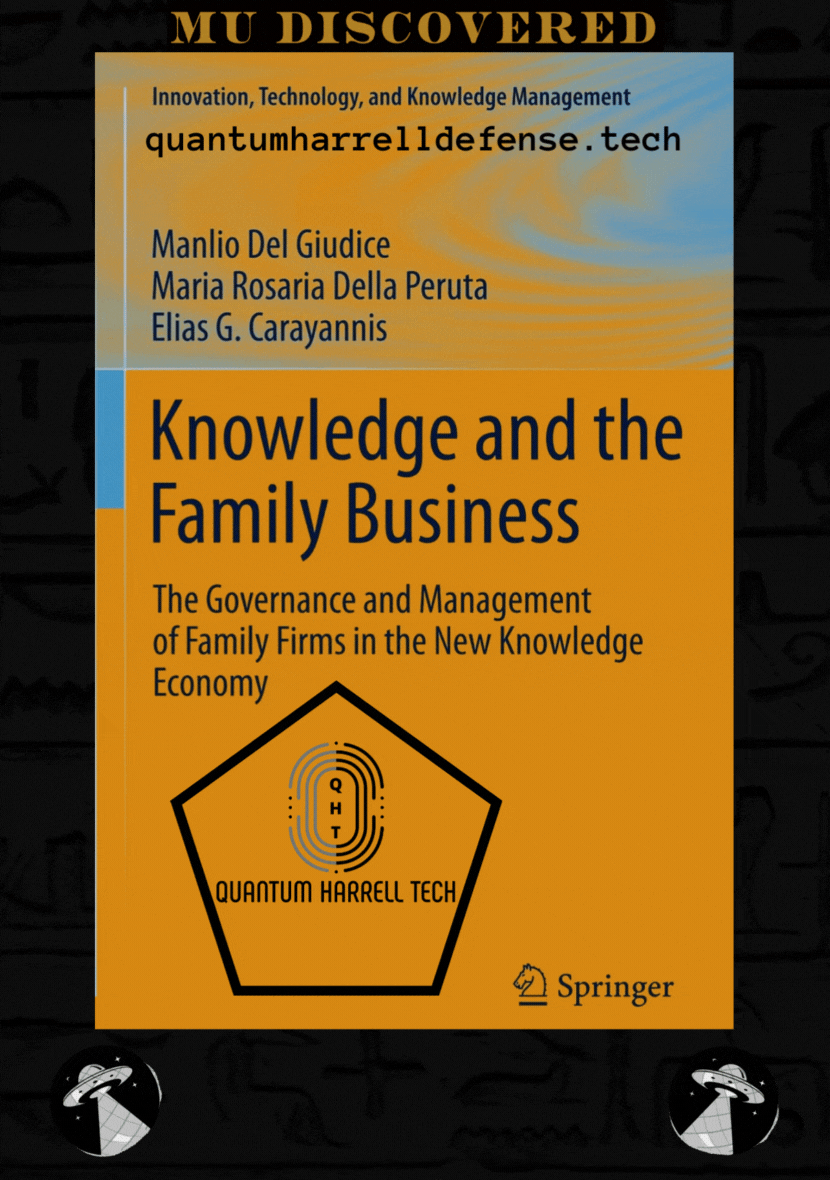
SIRIUS 1921steelecartel.tech of 1948 BETELGEUSE steelecartel.com wealth

EYE HEIL MY FATHER of ibmichaelstadtcoburg.com @ quantumharrelltech.gov!!!

My Ancient 1946 HURRIAN-HARRELL Father Married into Marie HITTITE's 1921steelecartel.tech Family Empire [DYNASTY] of Inner Earth's [HADES] Most Darkest [Occulted] Wrought Mineral Iron [MI = MICHAEL] & GOLDEN STEEL WEALTH @ 1921 QUANTUM 2023 HARRELL 2024 TECH 2025 Apple & IBM [A.i.] LLC of ATLANTIS [L.A.] 5000

I.B.1968 MICHAEL [IBM] @ 1921 QUANTUM 2023 HARRELL 2024 TECH 2025 Apple & IBM [A.i.] LLC of ATLANTIS [L.A.] 5000

eye technologically [e.t.] using autoCAD @ 1921 QUANTUM 2023 HARRELL 2024 TECH 2025 Apple & IBM [A.i.] LLC of ATLANTIS [L.A.] 5000

Pentagon defense.gov of 1921 QUANTUM 2023 HARRELL 2024 TECH 2025 Apple & IBM [A.i.] LLC of ATLANTIS [L.A.] 5000

trillions?!?!?!... try 2024 quadrillions!!!

1968michaelharrelljr.com_putah [ptah] services of applied quantumharrell.tech security... bee expensive af!!!
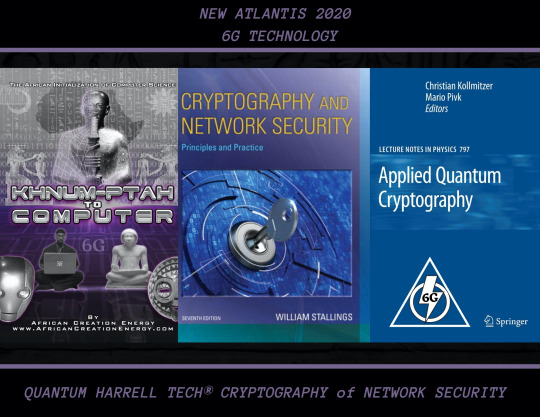
quantumharrell.tech of ANU GOLDEN 9 Ether [AGE] defense.gov @ 1921 QUANTUM 2023 HARRELL 2024 TECH 2025 Apple & IBM [A.i.] LLC of ATLANTIS [L.A.] 5000

© 1698-2223 QUANTUM HARRELL TECH LLC All Pentagon DotCom defense.gov Department Domain Rights Reserved @ 1921 QUANTUM 2023 HARRELL 2024 T-Mobile 2025 Apple & IBM [A.i.] LLC of ATLANTIS [L.A.] 5000
#harrelltut#harrelltut.com#pentagon#igigiskypentagon.tech#u.s. michael harrell#quantumharrelltech#kingtutdna.com#o michael#kemet#mu:13#king tut#quantumharrelltut#apple#apple patents#ibm#ibm patents#mac#macbook#laptop#airpods#smartphone#apple watch#imac#9etherlightshipatlantis
1 note
·
View note
Text
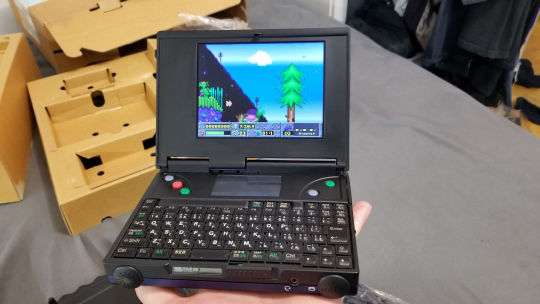

IBM Palm Top PC110
579 notes
·
View notes
Text
#computer#keyboard#laptop#usb#ibm#phones#smart tech#smart gadgets#devices#amazondeals#amazon delivery#amazon devices
1 note
·
View note
Text
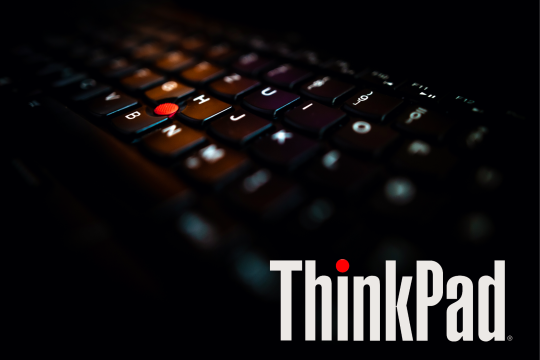

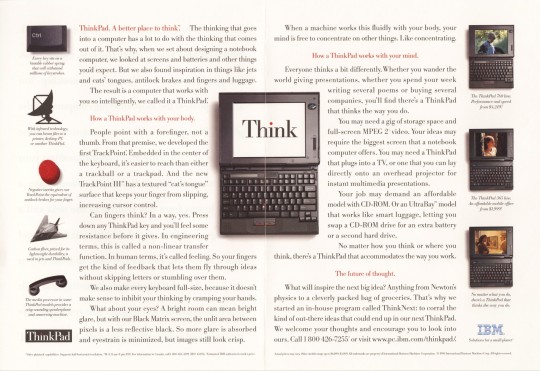

🇺🇲 Explore the fascinating journey of the iconic ThinkPad! Originally introduced by IBM in 1992, the ThinkPad quickly became synonymous with innovation, reliability, and cutting-edge technology.
💼 Designed for professionals on the go, the ThinkPad's signature black design, red TrackPoint, and durable build set it apart from the competition. ThinkPad was initially developed by a team led by Arimasa Naitoh, who drew inspiration from the traditional Japanese bento box for its design.
💻 Over the years, the ThinkPad underwent several transformations, adapting to the ever-changing landscape of technology. From the classic clamshell design to convertible tablets and ultrabooks, each iteration pushed the boundaries of what a laptop could achieve. The butterfly keyboard introduced on the ThinkPad 701C in 1995 was named one of the "25 Greatest PCs of All Time" by PC World.
🚀 Since the early 2000s, ThinkPads have been a trusted companion for astronauts aboard the International Space Station (ISS). ThinkPads have been instrumental in assisting astronauts with various tasks onboard the ISS, including data analysis, communication with mission control, and conducting scientific experiments.
💾 Despite changing hands from IBM to Lenovo in 2005, the ThinkPad's commitment to quality and innovation remained unwavering. Under Lenovo's stewardship, it continued to thrive, evolving with the times while staying true to its heritage.The iconic red TrackPoint remains a staple feature across generations, beloved by users for its precision and ease of use.
🌟 Today, the ThinkPad remains a symbol of excellence in the world of computing, beloved by professionals and enthusiasts alike for its reliability, performance, and timeless design. From business executives to tech enthusiasts, it became the go-to choice for anyone seeking performance and versatility.
#TechTime Chronicles#gadgets#history#laptops#1990#2000s web#old technology#ibm#ibm pc#lenovo#thinkpad#space#space station#TrackPoint#made in usa#usa#made in china#china#brands#companies#2000s tech#technology#old tech#retro tech#technews#tech#innovation#innovative#y2k#electronic
12 notes
·
View notes
Text
Lenovo IBM Laptop Bios Bin Files Free Download for All Models
Lenovo IBM Laptop Bios Bin Files Free Download for All Models
Hi, there guys We are going to provide you with all models of Lenovo IBM laptop Bios Bin Files in this new collection of laptop BIOS. Each and every one of you are welcome to download anything from this page because all the files that have been placed here are openly accessible.
All of the Provided Lenovo IBM bios bin files have not been tested and have been gathered from various internet…

View On WordPress
0 notes
Text
How McDonald's and IBM Partnership Personalize the Drive-In Experience | KKG INFO
How McDonald’s and IBM Partnership Personalize the Drive-In Experience | KKG INFO
IBM has teamed up to personalize the McDonald’s drive-thru experience. McDonald’s, which has adopted a data-driven marketing and growth strategy in recent years, has decided to partner with IBM, a provider of artificial intelligence products and solutions for businesses.
McDonald’s strategy focused on technology and growth
First, McDonald’s in 2019 Acceleration curves Let us remind you that it…

View On WordPress
#DriveIn#experience#IBM#ieee papers on latest technology#INFO#KKG#latest technology ai#latest technology door locks#latest technology in gaming#latest technology laptop#latest technology of solar panels#latest technology research topics#McDonalds#partnership#Personalize
0 notes
Text
The Framework is the most exciting laptop I've ever broken

From the moment I started using computers, I wanted to help other people use them. I was everyone’s tech support for years, which prepared me for the decade or so when I was a CIO-for-hire. In the early days of the internet, I spent endless hours helping my BBS friends find their way onto the net.
Helping other people use technology requires humility: you have to want to help them realize their goals, which may be totally unlike your own. You have to listen carefully and take care not to make assumptions about how they “should” use tech. You may be a tech expert, but they are experts on themselves.
This is a balancing act, because it’s possible to be too deferential to someone else’s needs. As much as other people know about how they want technology to work, if you’re their guide, you have to help them understand how technology will fail.
For example, using the same memorable, short password for all your services works well, but it fails horribly. When one of those passwords leak, identity thieves can take over all of your friend’s accounts. They may think, “Oh, no one would bother with my account, I’ve got nothing of value,” so you have to help them understand how opportunistic attacks work.
Yes, they might never be individually targeted, but they might be targeted collectively, say, to have their social media accounts hijacked to spread malware to their contacts.
Paying attention to how things work without thinking about how they fail is a recipe for disaster. It’s the reasoning that has people plow their savings into speculative assets that are going up and up, without any theory of when that bubble might pop and leave them ruined.
It’s hard to learn about failure without experiencing it, so those of us who have lived through failures have a duty to help the people we care about understand those calamities without living through them themselves.
That’s why, for two decades, I’ve always bought my hardware with an eye to how it fails every bit as much as how it works. Back when I was a Mac user — and supporting hundreds of other Mac users — I bought two Powerbooks at a time.
I knew from hard experience that Applecare service depots were completely unpredictable and that once you mailed off your computer for service, it might disappear into the organization’s bowels for weeks or even (in one memorable case), months.
I knew that I would eventually break my laptop, and so I kept a second one in sync with it through regular system-to-system transfers. When my primary system died, I’d wipe it (if I could!) and return it to Apple and switch to the backup and hope the main system came back to me before I broke the backup system.
This wasn’t just expensive — it was very technologically challenging. The proliferation of DRM and other “anti-piracy” measures on the Mac increasingly caused key processes to fail if you simply copied a dead system’s drive into a good one.
Then, in 2006, I switched operating systems to Ubuntu, a user-centric, easy-to-use flavor of GNU/Linux. Ubuntu was originally developed with the idea that its users would include Sub-Saharan African classrooms, where network access was spotty and where technical experts might be far from users.
To fulfill this design requirement, the Ubuntu team focused themselves on working well, but also failing gracefully, with the idea that users might have to troubleshoot their own technological problems.
One advantage of Ubuntu: it would run on lots of different hardware, including IBM’s Thinkpads. The Thinkpads were legendarily rugged, but even more importantly, Thinkpad owners could opt into a far more reliable service regime that Applecare.
For about $150/year, IBM offered a next-day, on-site, worldwide hardware replacement warranty. That meant that if your laptop broke, IBM would dispatch a technician with parts to wherever you were, anywhere in the world, and fix your computer, within a day or so.
This was a remnant of the IBM Global Services business, created to supply tech support to people who bought million-dollar mainframes, and laptop users could ride on its coattails. It worked beautifully — I’ll never forget the day an IBM technician showed up at my Mumbai hotel while I was there researching a novel and fixed my laptop on the hotel-room desk.
This service was made possible in part by the Thinkpad’s hardware design. Unlike the Powerbook, Thinkpads were easy to take apart. Early on in my Thinkpad years, I realized I could save a lot of money by buying my own hard-drives and RAM separately and installing them myself, which took one screwdriver and about five minutes.
The keyboards were also beautifully simple to replace, which was great because I’m a thumpy typist and I would inevitably wear out at least one keyboard. The first Thinkpad keyboard swap I did took less than a minute, and I performed it one-handed, while holding my infant daughter in my other hand, and didn’t even need to read the documentation!
But then IBM sold the business to Lenovo and it started to go downhill. Keyboard replacements got harder, the hardware itself became far less reliable, and they started to move proprietary blobs onto their motherboards that made installing Ubuntu into a major technical challenge.
Then, in 2021, I heard about a new kind of computer: the Framework, which was designed to be maintained by its users, even if they weren’t very technical.
https://frame.work/
The Framework was small and light — about the same size as a Macbook — and very powerful, but you could field-strip it in 15 minutes with a single screwdriver, which shipped with the laptop.
I pre-ordered a Framework as soon as I heard about it, and got mine as part of the first batch of systems. I ordered mine as a kit — disassembled, requiring that I install the drive, RAM and wifi card, as well as the amazing, snap-fit modular expansion ports. It was a breeze to set up, even if I did struggle a little with the wifi card antenna connectors (they subsequently posted a video that made this step a lot easier):
https://twitter.com/frameworkputer/status/1433320060429373440
The Framework works beautifully, but it fails even better. Not long after I got my Framework, I had a hip replacement; as if in sympathy, my Framework’s hinges also needed replacing (a hazard of buying the first batch of a new system is that you get to help the manufacturer spot problems in their parts).
My Framework “failed” — it needed a new hinge — but it failed so well. Framework shipped me a new part, and I swapped my computer’s hinges, one day after my hip replacement. I couldn’t sit up more than 40 degrees, I was high af on painkillers, and I managed the swap in under 15 minutes. That’s graceful failure.
https://guides.frame.work/Guide/Hinge+Replacement+Guide/104
After a few weeks’ use, I was convinced. I published my review, calling the Framework “the most exciting laptop I’ve ever used.”
https://pluralistic.net/2021/09/21/monica-byrne/#think-different
That was more than a year ago. In the intervening time, I’ve got to discover just how much punishment my Framework can take (I’ve been back out on the road with various book publicity events and speaking engagements) and also where its limits are. I’ve replaced the screen and the keyboard, and I’ve even upgraded the processor:
https://guides.frame.work/Guide/Mainboard+Replacement+Guide/79
I’m loving this computer so. damn. much. But as of this morning, I love it even more. On Thursday, I was in Edinburgh for the UK launch of “Chokepoint Capitalism,” my latest book, which I co-authored with Rebecca Giblin.
As I was getting out of a cab for a launch-day podcast appearance, I dropped my Framework from a height of five feet, right onto the pavement. I had been working on the laptop right until the moment the cab arrived because touring is nuts. I’ve got about 150% more commitments than I normally do, and I basically start working every day at 5AM and keep going until I drop at midnight, every single day.
As rugged as my Framework is, that drop did for it. It got an ugly dent in the input cover assembly and — far, far worse — I cracked my screen. The whole left third of my screen was black, and the rest of it was crazed with artefacts and lines.
This is a catastrophe. I don’t have any time for downtime. Just today, I’ve got two columns due, a conference appearance and a radio interview, which all require my laptop. I got in touch with Framework and explained my dire straits and they helpfully expedited shipping of a new $179 screen.
Yesterday, my laptop screen stopped working altogether. I was in Oxford all day, and finished my last book event at about 9PM. I got back to my hotel in London at 11:30, and my display was waiting for me at the front desk. I staggered bleary-eyed to my room, sat down at the desk, and, in about fifteen minutes flat, I swapped out the old screen and put in the new one.
https://guides.frame.work/Guide/Display+Replacement+Guide/86
That is a fucking astoundingly graceful failure mode.
Entropy is an unavoidable fact of life. “Just don’t drop your laptop” is great advice, but it’s easier said than done, especially when you’re racing from one commitment to the next without a spare moment in between.
Framework has designed a small, powerful, lightweight machine — it works well. But they’ve also designs a computer that, when you drop it, you can fix yourself. That attention to graceful failure saved my ass.
If you hear me today on CBC Sunday Magazine, or tune into my Aaron Swartz Day talk, or read my columns at Medium and Locus, that’s all down to this graceful failure mode. Framework’s computers aren’t just the most exciting laptops I’ve ever used — they’re the most exciting laptops I’ve ever broken.
[Image ID: A disassembled Framework laptop; a man's hand reaches into the shot with a replacement screen.]
1K notes
·
View notes
Quote
One might even say that it’s one of the scandals of capitalism that most firms operate internally on communistic principles. True, they tend not to operate particularly democratically. Most often they are organized by military-style top-down chains of command. But still, there is often an interesting tension here, because actually, top-down chains of command are not really very efficient (they tend to promote stupidity among those on top, resentment among those on the bottom). The more one has to improvise, the greater the need for democratic co-operation. Inventors have always known this and start-up capitalists and computer engineers have recently rediscovered the principle: not only with things like freeware, which everyone talks about, but even in the organization of their businesses. Apple Computers is a famous example: it was founded by (mostly Republican) computer engineers who broke from IBM in Silicon Valley in the 1980s, forming little democratic circles of twenty to forty people with their laptops in each other’s garages. This is presumably also why in the immediate wake of great disasters — a flood, blackout, revolution or economic collapse — people tend to behave the same way, reverting to a kind of rough-and-ready communism. Suddenly, if only for a short time, hierarchies, markets and the like become luxuries that no one can really afford
David Graeber
22 notes
·
View notes